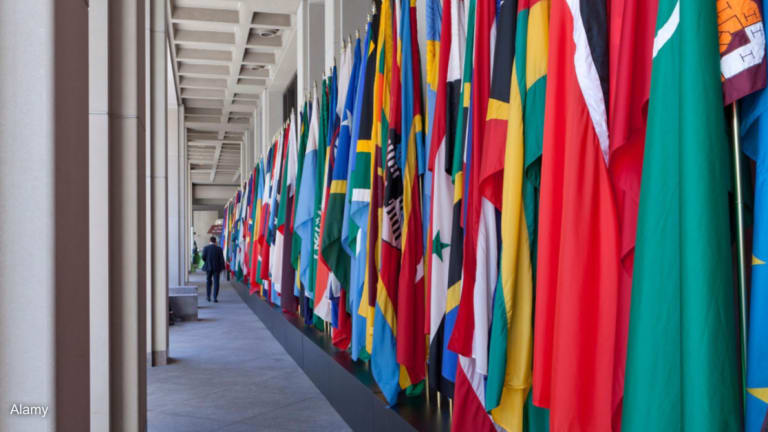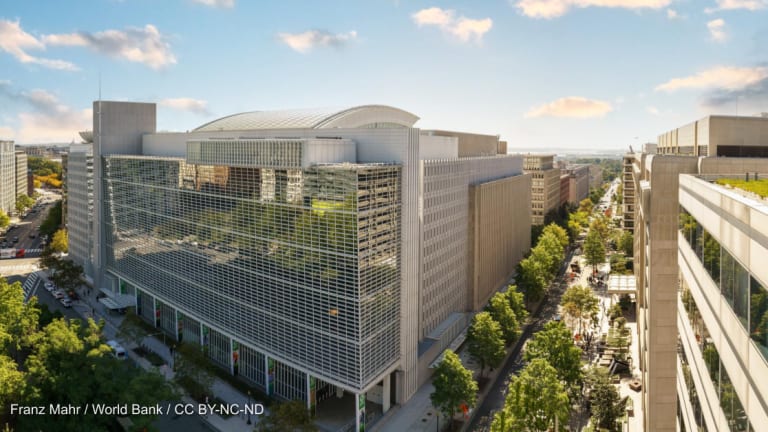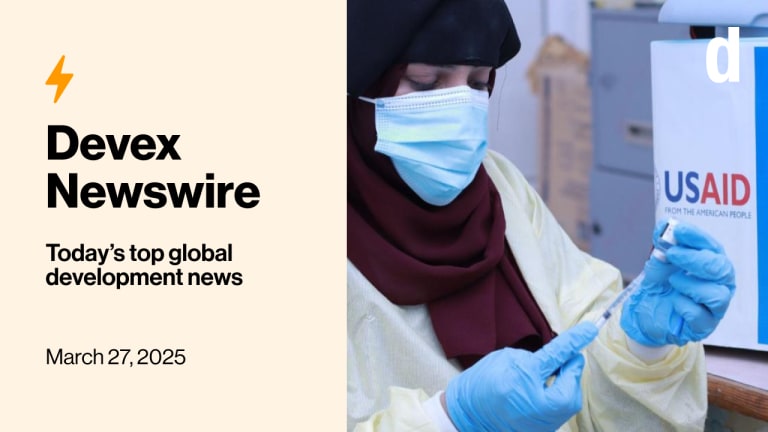Interactive: Who wins AfDB contracts, and what for?
In the first part of a Devex series on bidding for contracts with the African Development Bank, we analyze 16 years' worth of contract awards data to reveal trends in where the money is going — including sectors, countries and contractor nationalities.
Ever since its founding, the African Development Bank has worked with a broad range of partners and implementers in the pursuit of its mission. For these partners and implementers — from engineering contractors to automobile distributors; from development consultancies to non-profit research institutes — the bank’s loans, grants, and non-project financial operations, which are used to drive development in Africa, constitute a lucrative market. However, this “market” is highly structured — something that has both benefits and drawbacks when it comes to doing business in Africa. As Devex learned in conversations with successful AfDB contractors — highlights from which will be published next week — doing business with the bank mitigates some of the risks that firms face on the continent, but also entails more stringent requirements and more complex regulations than typical business-to-government deals. To better understand this “market” for AfDB development contracts, Devex has analyzed and visualized all of AfDB’s contract awards data from 2000 through 2016. During this time, AfDB awarded over $26 billion in nearly 30,000 contracts for projects across Africa. The data reveals how AfDB contracting has changed over time, allowing us to compare geographical and sectoral allocations of funding, as well as the success of different contractors or groups of contractors over time. Insights like these can be helpful for both long-standing and aspiring AfDB contractors, especially when seeking partners or researching competitors for new opportunities. In this new series, Devex dives into the data to discover what it can tell us about the past, present, and future of contracting with the AfDB, and speaks to bank officials, contractors and other insiders with insight into the AfDB marketplace. In this first part of the series, we explain the nature of the data we’ve gathered and analyzed — and walk through the major insights it gives us about the market for AfDB-funded opportunities. About the data The analyses, graphics, and dashboards in this AfDB Contractor Insights series are based on data recently made available by AfDB online. AfDB makes available for public use a plethora of data related to its operations and impact, as well as Africa’s development. The new dataset included the bank’s history of contract awards — awards of funding to organizations for the purpose of implementing development projects across the continent. It included information on the dollar amounts of the awards; the names and nationalities of the awardees; and the location, name, sector, and ID of the linked AfDB project, all of which we used in our analysis and visualizations below. A growing market, especially for infrastructure According to the available data, AfDB awards drastically increased between 2000 and 2016. For the first six years of that period, annual awards tended to hover around $600 million per year, but then grew rapidly over 2007 and 2008 to $2.1 billion. The annual figure oscillated around this $2.1 billion mark through 2015, before just recently dipping to $1.7 billion in 2016. The abrupt spike between 2006 and 2008 may be due to more complete reporting by the bank. However, if the data is indeed complete, this change represents a 166 percent increase in annual awards over a short, two year period. Most of this “spike” is attributable to increased AfDB spending on transport and energy infrastructure projects. After 2006 the bank began awarding contracts of an unprecedented size, for the implementation of infrastructure “super-projects.” The size of the typical AfDB award for transport or energy contracts also grew dramatically after 2006 — from $1-3 million per contract to between $5-10 million per contract — while the average contract size of awards in other sectors remained fairly flat through the 16 years of data. However, where the size of infrastructure contracts increased, the quantity of other projects rose. Gradual increases in the number of awards to other sectors — particularly agriculture and water — after 2006 helped to bolster and maintain record-high levels of annual awards through 2015. Where, what, and why The available AfDB awards data allows us to answer two questions about the geographical nature of AfDB’s activities: where does its funding go, and where do its partners come from? Over $10 billion of AfDB funding, or about 40 percent of awards distributed from 2000 through 2016, went to six key Northern and Eastern African countries’ projects: Morocco, Tunisia, Egypt, Uganda, Kenya, and Tanzania. All six consistently had active projects that received awards each year from 2000 through 2016, with a number of abrupt peak years when hundreds of millions of dollars worth of awards were made for one or two of the “super projects”. It also appears that African countries with strong ecosystems of local contractors tended to be those where more AfDB awards were allocated: Morocco, Tunisia, and Uganda, for example. This correlation can’t be said to be causative from the awards data alone. It is not possible to say from the data whether approving projects in a country helped develop a local ecosystem of contractors, or whether countries were favored as project destinations because they had a healthy market of contractors. What we can tell from this data is that these countries are likely to be locations of capable partners — or tough competitors — for future AfDB contracts. The success of Chinese contractors is tough to miss in the data. With $6.2 billion in awards from 2000 to 2016, Chinese firms wons 24 percent of AfDB awards during this time across a broad range of sectors, though mostly in transportation infrastructure. Contractors from China, as well as from other Asian countries, took great advantage of the 2007-08 spike in awards, especially in the transportation and energy sectors. The traditional contractors in these sectors, mostly from Europe, are increasingly embattled by rising Asian and African firms in the competition for AfDB awards — as will be explored in greater depth later in the series. Interested in learning more about AfDB contractors? Visit our interactive dashboards to explore and analyze the data yourself; read more from our coverage on AfDB’s top 2016 contractors and top NGO contractors; and keep an eye out for further articles in our AfDB Contractor Insights series. Do you have questions about our methodology or data insights? Reach out to our experts at analysts@devex.com for more information.
Ever since its founding, the African Development Bank has worked with a broad range of partners and implementers in the pursuit of its mission. For these partners and implementers — from engineering contractors to automobile distributors; from development consultancies to non-profit research institutes — the bank’s loans, grants, and non-project financial operations, which are used to drive development in Africa, constitute a lucrative market. However, this “market” is highly structured — something that has both benefits and drawbacks when it comes to doing business in Africa. As Devex learned in conversations with successful AfDB contractors — highlights from which will be published next week — doing business with the bank mitigates some of the risks that firms face on the continent, but also entails more stringent requirements and more complex regulations than typical business-to-government deals.
To better understand this “market” for AfDB development contracts, Devex has analyzed and visualized all of AfDB’s contract awards data from 2000 through 2016. During this time, AfDB awarded over $26 billion in nearly 30,000 contracts for projects across Africa. The data reveals how AfDB contracting has changed over time, allowing us to compare geographical and sectoral allocations of funding, as well as the success of different contractors or groups of contractors over time. Insights like these can be helpful for both long-standing and aspiring AfDB contractors, especially when seeking partners or researching competitors for new opportunities.
In this new series, Devex dives into the data to discover what it can tell us about the past, present, and future of contracting with the AfDB, and speaks to bank officials, contractors and other insiders with insight into the AfDB marketplace.
This story is forDevex Promembers
Unlock this story now with a 15-day free trial of Devex Pro.
With a Devex Pro subscription you'll get access to deeper analysis and exclusive insights from our reporters and analysts.
Start my free trialRequest a group subscription Printing articles to share with others is a breach of our terms and conditions and copyright policy. Please use the sharing options on the left side of the article. Devex Pro members may share up to 10 articles per month using the Pro share tool ( ).
Matthew Wolf works with the Devex Analytics team from Johannesburg in South Africa, helping improve our coverage of and insight into development work and funding around the world. He draws on work experience with Thomson Reuters in Africa, MENA and Latin America, where he helped uncover, pursue and win opportunities with local governments and donor agencies. He is interested in data-driven solutions to development challenges, results-based financing, and ICT4D.




